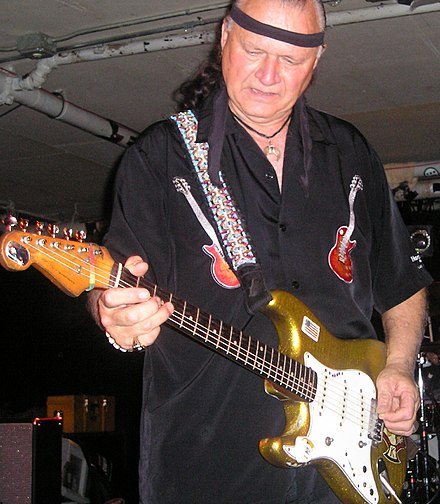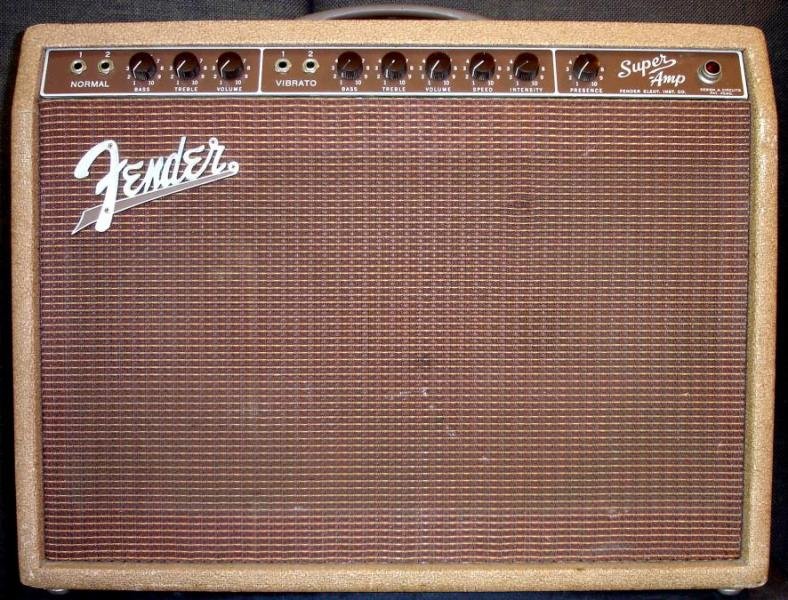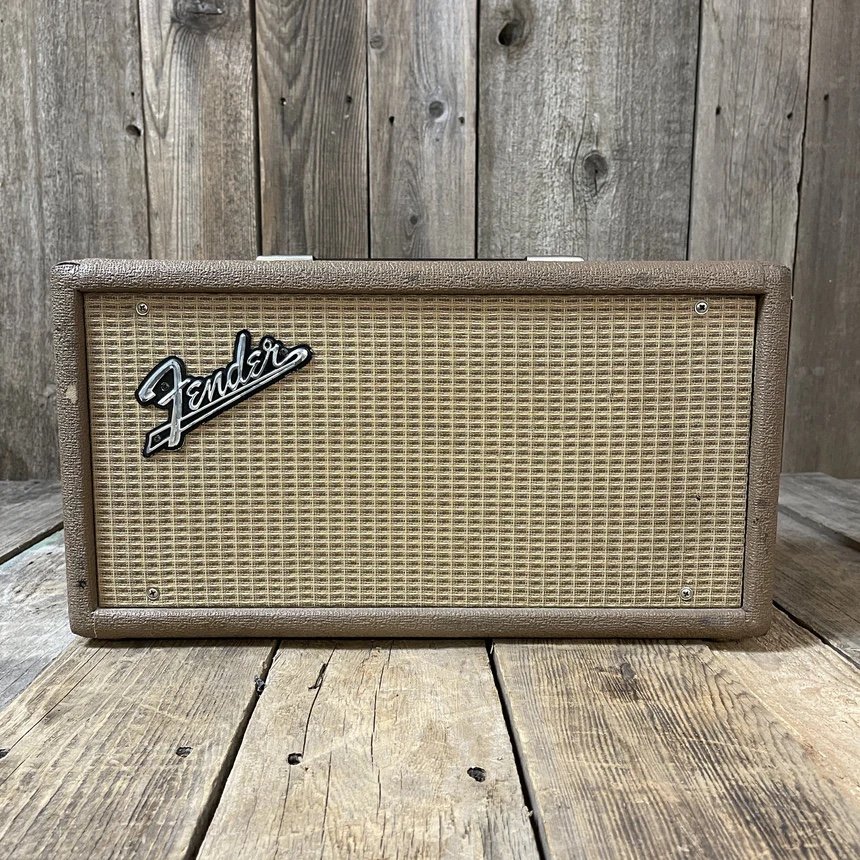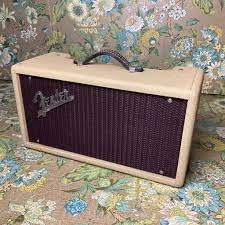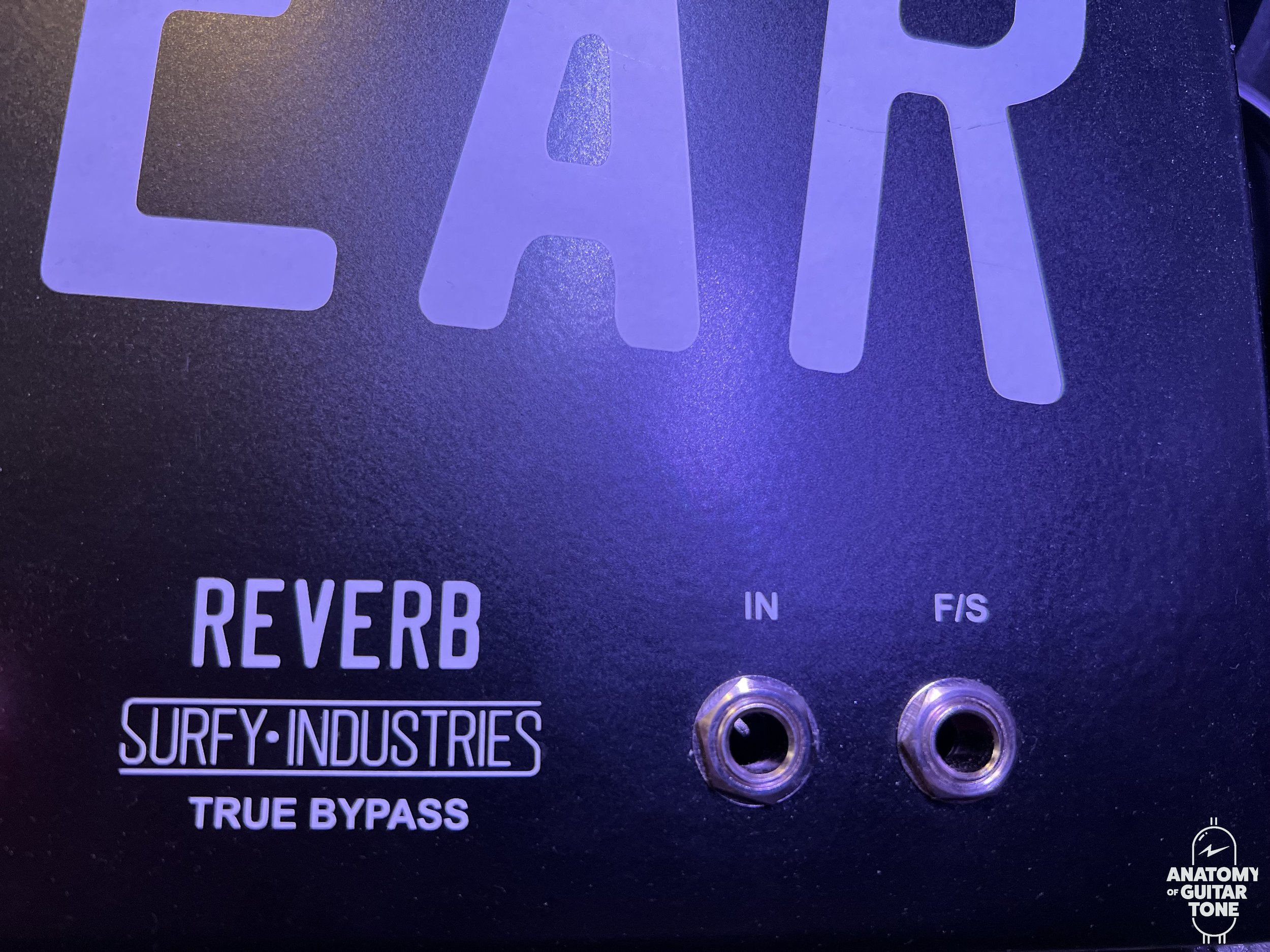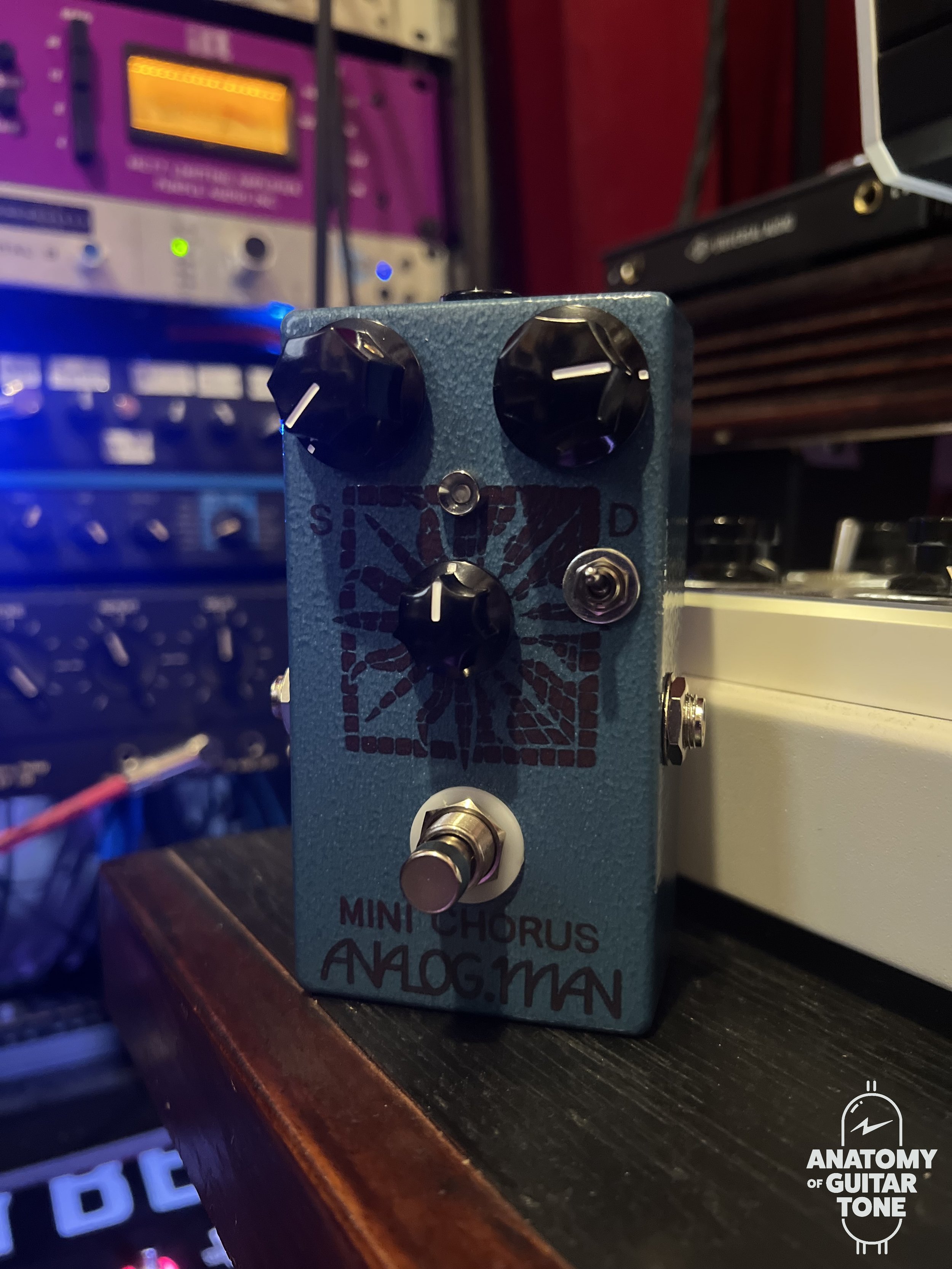Surfybear Metal
As simple as surf guitar tones sound, capturing them is pretty elusive. Just as with cooking, the fewer the ingredients, the greater the quality each ingredient must have. No disguises or distractions will work.
Surf guitar is generally a guitar, reverb, and an amp. Sometimes an early fuzz like the Maestro FZ-1A is involved. But primarily it’s guitar to reverb to amp.
Each ingredient must be high-quality to truly capture the classic surf guitar tone of artists like Dick Dale and the Ventures.
Dick Dale
Amp
1959 Fender Brownface Super
Much of the classic surf-era guitar tones were recorded using tweed and brownface Fender amps or, in the case of the Shadows, Vox amps. Blackface Fender amps didn't appear on the market until the end of the peak of instrumental surf.
None of these amps had built-in reverb. Instead, Fender made a 6G15 vacuum tube spring reverb unit that connected to the amp. The 6G15 sounds different from the reverbs that appeared in Fender amps in later years. Not better or worse—unless we're talking about the surf guitar tone.
Pre CBS Fender 6G15 Reverb
There’s an aggression and a harmonic richness to the 6G15 circuit. People often use the word “clean” when describing surf guitar. But to my ears, it’s somewhat clean and pretty saturated. That saturation comes from the tubes in the 6G15 tank and the brownface/blonde or tweed amp playing loud. The result is a harmonic complexity in the tone of surf guitar.
Fender stopped making the 6G15 reverb unit in 1966, as reverb had become standard in its amps. Guitarists were pleased not to have to carry another large piece of gear.
Built-in reverb tanks and digital reverb ushered in new eras of guitar reverb tones. But for those who love the sound of surf music, it became harder to recreate the authentic surf vibe.
Reissue
1990’s Fender 6G15 Reissue
In the '90s, Fender started reissuing the 6G15 reverb unit, but not precisely to vintage spec. To me, it's not quite right, which is how I feel about many Fender reissues in general. Some guitarists modded these reissue 6G15 units to the "correct" specs. Fender stopped making the reissues in 2016.
Although I don't think the reissues sounded the same with the replacement tube, it was one of the only options.
Pedal Format
I've been chasing the surf reverb tone for years. First I tried the ValveTrain SpringThing, which lacked excitement. Then I tried the VanAmps Sole-Mate, which had a bit of a thing but was unreliable. Neither was the true surf guitar tone.
I also tried the Anasounds Element reverb, which was my least favorite of all. I had significant issues with its tone and construction.
The only spring reverb I kept from my explorations was the Demeter Reverbulator. It's a fantastic spring reverb. But it's not the surf sound. It does work wonderfully for a lot of other applications, however.
I then tried the many pedals that model spring reverbs. I was disappointed every time. I'm not saying that some of these pedals couldn't be good, practical solutions when the highest fidelity to real surf tone isn't necessary. More that they don't react to your playing or come to life as a 6G15 does.
When I find the right gear, I feel like I play it. My favorite gear feels interactive. That expressiveness is missing from emulations and digital pedals.
Different players relate differently to their gear. Some players don't interact with equipment quite the same way as I do and would be happy with the practical pedals I just mentioned.
But the nuances become incredibly important for those of us who react to sound the same way we react to pitch.
Genuine
I was skeptical when I first came across Surfy Industries. I’d tried so many spring reverbs and had given up on getting an authentic surf guitar reverb with anything but a vintage 6G15.
But I decided to try the Surfybear Metal, which is the 6G15 circuit without tubes. The missing tubes was an eyebrow raiser. But somehow, Surfy Industries has done it.
Plugging in the Surfybear Metal was instant gratification. I got it just before a soundcheck for a gig featuring songs from my project Mark Marshall's Future Relics, which are in the surf genre.
Gigs are pretty unforgiving with gear. You can plug into something at home that sounds great. And when you bring it on stage, it folds.
So it was risky to take the Surfybear right from the box to the stage (but not before I quickly plugged it in to make sure I was getting a signal). It paid off, though, as it considerably influenced my playing on the gig. I played differently because the sound felt like a collaborative effort between the Surfybear Metal and me.
And that’s the difference with great analog gear.
Quiet Please
I was also surprised by the Surfybear’s low noise floor. Noise is a consistent issue with many springs reverbs.
I’ve found the VanAmps Sole-Mate and SpringThing hard to use on gigs because of their noise. The Surfybear has been quiet in the studio and on gigs.
Real Estate
The Surfybear Metal is relatively large—the length of a lot of pedalboards. It makes sense if you think about it: there are real springs inside. It's not a spring reverb emulator. It's a real spring reverb. Its dimensions are approx. 44 x 17 x 8 cm (17.5 x 6.5 x 3 inches).
It’s not a pedal you’ll have around for just a few songs. The Surfybear will be a big part of your core tone. But if you're into surf tone, the commitment is worth it. This pedal is made for you.
I’ve tried modern pedals that put springs in a small enclosure. I find most of them unusable. For better or worse, you need size to get true surf tone.
But remember, it doesn't take that many elements to get authentic surf guitar tone. Those elements just need to be extraordinary.
The Surfybear Metal also fits in a rack unit. I place mine on a shelf for studio use.
Panning Out
Surfy Industries has collaborated with Accutronics on the reverb pan in the Surfybear Metal. Surfy Industries has obviously set out to nail the surf guitar reverb tone.
Accutronics reverb has a longer reverb tail than the original Fender pans. So Surfy Industries worked with Accutronics to produce a new pan that recreates the classic early ‘60s reverb tones, including a period-correct decay.
Sonic Excitement
One thing I love about the Surfybear and the original Fender 6G15 is the splashy, dynamic sound of the reverb. The more you push your pick attack, the more wash and swell you get in the reverb.
It's not one constant reverb tone—it changes based on what you feed it and how much signal you provide. If you turn your volume down or use a lot less pick attack, the reverb's tone mellows. As you push harder, the reverb becomes more present, brighter, and aggressive.
The Surfybear Metal does this with guitars, Mellotron, organ, synths, or anything else you feed it. There’s an exciting crunchiness when you crank the tone knob. Rolling back the tone knob produces lovely, subtle spring reverb.
The Surfybear Metal isn't a one-trick pony. I enjoy using it with my Prophet 10 and OB-6 synths for a short, dark spring sound that adds a little air to the signal.
This is a pedal with lot of texture.
Controls
The Surfybear Metal has four controls: volume, tone, mixer, and dwell. The volume knob is handy, as there is often some signal loss with reverb. It helps you keep the gain staging you want for your amp.
I reach for the tone knob a lot. Fully cranked, you can achieve a lovely ocean-wavy reverb that’s harmonically rich. Pulling the tone knob back allows for more subtlety and depth.
I use the dwell knob often, too. This changes the length of the reverb. When using the Surfybear with my Prophet 10 or Mellotron, I'm constantly tweaking the tone and dwell knobs to get a variety of textures from subtle depth to straight-up ocean wash.
I like where the knobs are placed on the pedal. They’re easy to tweak on a gig or in the studio. On guitar gigs, I often reach down to adjust the mixer knob depending on the song. This ability to easily make quick adjustments seems purposely built into the pedal.
Jacks
The input and output jacks are top-mounted. You can connect the power supply (included) in the back or use another adapter, as long as it's 12v DC 1A Center Positive.
The Surfybear Metal also can be turned on and off with a remote foot switch. Even when operated with a remote pedal, the Surfy Bear is still true bypass.
Switch
Surfy Industries decided to use a switch with a light around it instead of a traditional LED, and I love the way it looks. It makes finding the button on a dark stage very easy.
It's tough to find anything wrong with the Surfybear Metal. It's the spring reverb I've been waiting for. The biggest complaint I think it will get is its size. It's not a pedal you’ll slap on a pedalboard alongside a dozen other toys. Surfy Industries does make a smaller spring reverb, but it doesn't use the Surfy pan with four springs. I'm sure it still sounds excellent, but it’s not the 6G15 sound.
For the examples below, I used the following signal chain:
All amps are run through the Ampete 88S Studio amp switcher, allowing me to switch between amps quickly.
I then run into a Universal Audio OX, which goes into an API 312 Preamp, Purple Audio MC77 analog compressor, and a UA Apollo interface into Luna.
Example 1:
A surf-inspired solo through four amps, showing how the Surfybear reacts to different amps.
1a: Fender Stratocaster with FSC '59 pickups and the Surfybear Metal into a Victoria 35115 Tweed "Pro."
1b: Fender Stratocaster with FSC '59 pickups and the Surfybear Metal into a Vox AC15 made in the early 1990s. I'm using the 2xACE top speakers.
1c: Fender Stratocaster with FSC '59 pickups Surfybear Metal into a Marshall SV20 Plexi with Greenback 25 speakers.
1d: Fender Stratocaster with FSC '59 pickups Surfybearr Metal into a Headstrong Lil’ King (blackface Princeton) using 2x12 Fender speakers.
Example 2: Based on one of my original surf compositions.
2a: Fender Stratocaster with FSC '59 pickups and the Surfybear Metal into a Victoria 35115 Tweed "Pro."
2b: Fender Stratocaster with FSC '59 pickups Surfybear Metal into a Vox AC15 made in the early 1990s. I'm using the 2xACE top speakers.
2c: Fender Stratocaster with FSC '59 pickups Surfybear Metal into a Marshall SV20 Plexi with Greenback 25 speakers.
2d: Fender Stratocaster with FSC '59 pickups and the Surfybear Metal into a Headstrong Lil’ King (blackface Princeton) using 2x12 Fender speakers.
Example 3: A riff inspired by one of my favorite Ventures songs.
3a: Fender Stratocaster with FSC '59 pickups Surfybear Metal into a Victoria 35115 Tweed "Pro."
3b: Fender Stratocaster with FSC '59 pickups Surfybear Metal into a Vox AC15 made in the early 1990s. I'm using the 2xACE top speakers.
3c: Fender Stratocaster with FSC '59 pickups and the Surfybear Metal into a Marshall SV20 Plexi with Greenback 25 speakers.
3d: Fender Stratocaster with FSC '59 pickups and the Surfybear Metal into a Headstrong Lil’ King (blackface Princeton) using 2x12 Fender speakers.
Example 4: A blues-inspired example using a Gibson 335 with Florance '59 humbuckers and the Surfybear Metal into the Headstrong Lil’ King.
Example 5: A rock-inspired part using a Gibson SG Custom with Gemini Mercury One Humbuckers and the Surfybear Metal into a Vox AC15.
Example 6: A heavy guitar riff using the Gibson SG Custom with Gemini Mercury One humbuckers into an Analog Man Sun Face BC108 with the Surfybear Metal into a Marshall SV20 Plexi using a modern 4x12 speaker cab.
Example 7: An experimental guitar part using the Gibson SG Custom with Gemini Mercury One humbuckers into an Analog Man Sun Face BC108 and the Surfybear Metal into the Marshall SV20 Plexi using a modern 4x12 speaker cab. I rolled the guitar volume far back and blended some neck pickup with the bridge.
Keys
Guitar pedals play well with synths. It's always good to think of other ways you may use gear when you buy it. I use guitar pedals on all kinds of sources in the studio besides guitar.
Example 8: Mellotron M4000D Mini with a 3 violins preset played at half speed into the Surfybear Metal.
Example 9: A Bernard Herrmann-inspired vibraphone motif using the Mellotron M4000D Mini into the Surfybear Metal.
Example 10: A Sequential Circuits Prophet-10 arpeggiated bass line into the Surfybear Metal. I'm "playing" the filter in real-time, which excites the reverb.
Example 11: A Stranger Things-inspired arpeggiated pattern using the Sequential Circuits Prophet-10 into an Analog Man Mini Chorus into the Surfybear Metal.
Example 12: A Dave Smith OB-6 motif played into an Analog Man Mini Chorus into the Surfybear Metal.
Example 13: A Dave Smith OB-6 chord sequence played into an Analog Man Mini Chorus into the Surfybear Metal.

